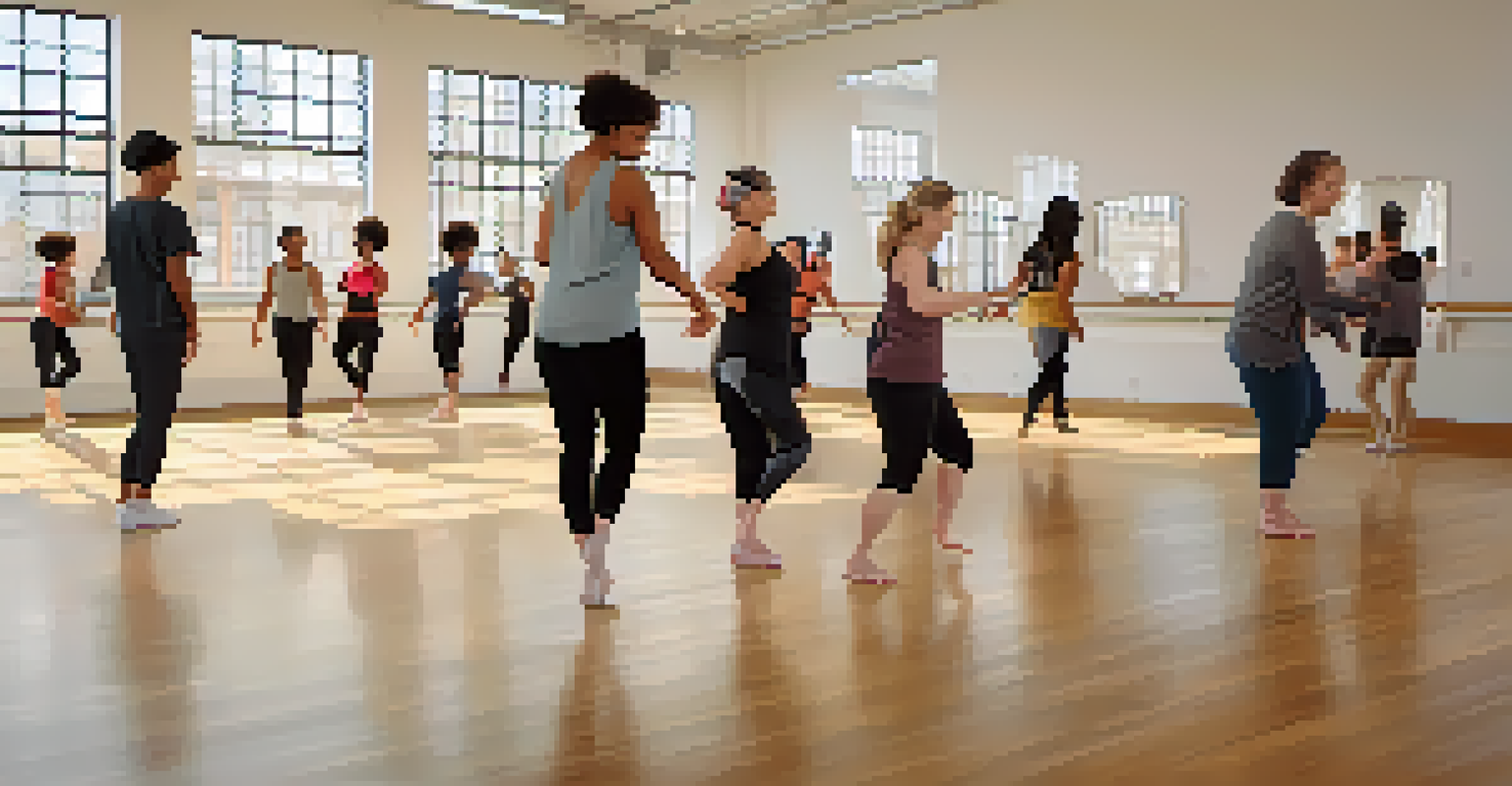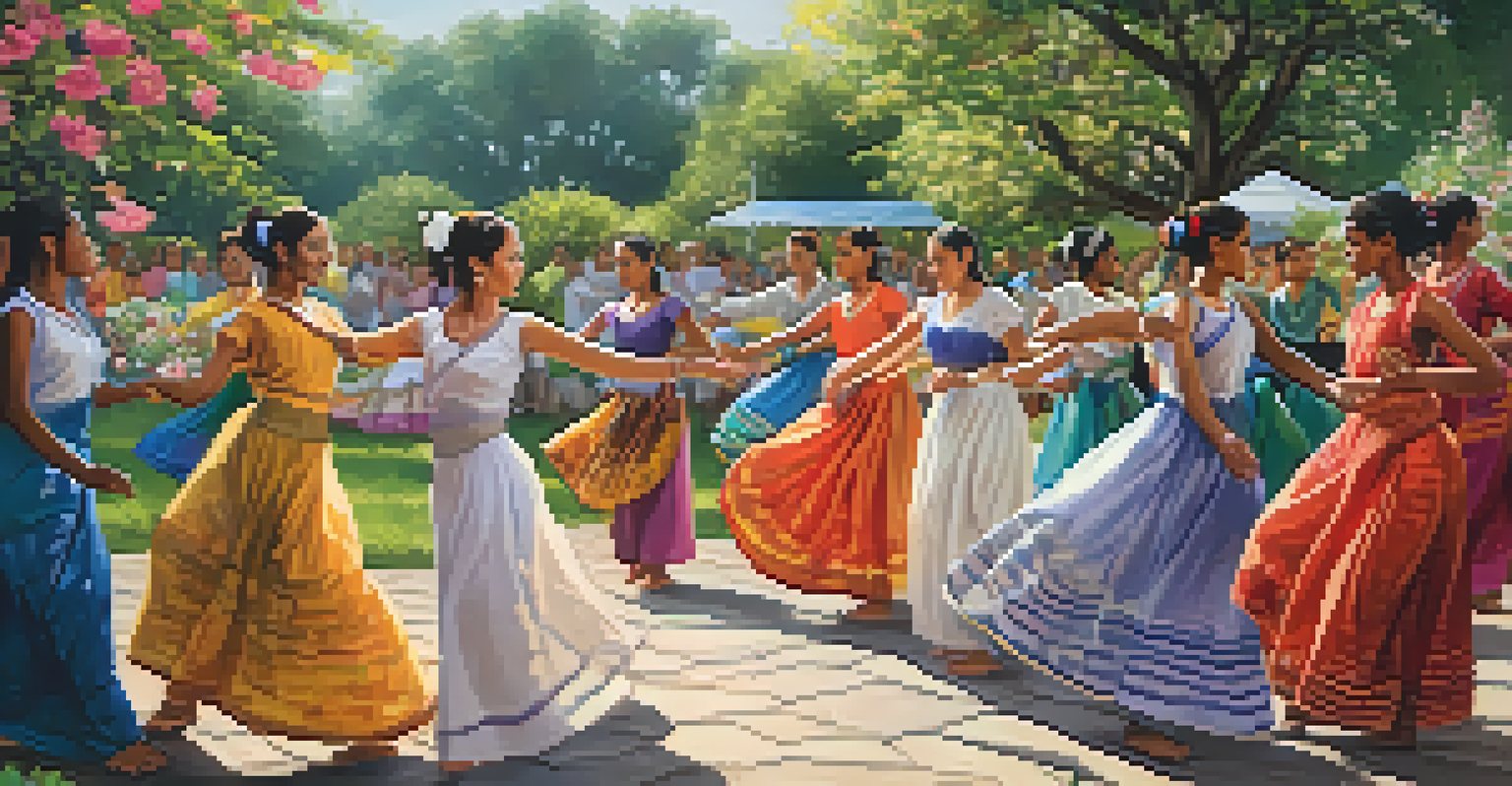Evaluating the Effects of Policy on Dance Accessibility

Understanding Dance Accessibility and Its Importance
Dance accessibility refers to the ease with which individuals can participate in dance activities, regardless of their physical abilities, socio-economic background, or cultural context. It's not just about the physical space; it encompasses financial, social, and educational factors that enable or hinder participation. When we talk about making dance accessible, we highlight the importance of inclusivity, ensuring that everyone can express themselves through movement.
Dance is the hidden language of the soul.
The significance of dance accessibility can be illustrated through community events that invite participation from all demographics. Imagine a local dance festival that offers free workshops for children with disabilities, encouraging creative expression and social interaction. Such initiatives not only foster talent but also build a sense of community, showcasing the transformative power of dance across diverse groups.
Moreover, accessible dance programs can improve mental health and well-being, providing a creative outlet for individuals facing various challenges. By breaking down barriers, we empower everyone to experience the joy of dance, further emphasizing the need for inclusive policies that prioritize access.
Current Policies Affecting Dance Accessibility
Policies surrounding dance accessibility vary widely, ranging from local government initiatives to national arts funding programs. Many governments have recognized the importance of inclusive arts policies and have implemented measures to ensure that funding is available for programs that cater to marginalized groups. However, the effectiveness of these policies often depends on their enforcement and the commitment of local organizations.

For example, some cities have adopted universal design principles in public spaces, ensuring that venues are accessible to everyone, including those with mobility challenges. These policies not only enhance physical access but also promote a culture of inclusivity within the arts community. However, there are still gaps in policy implementation, particularly in rural areas where resources are limited.
Importance of Dance Accessibility
Making dance accessible fosters inclusivity, allowing individuals from diverse backgrounds to express themselves through movement.
Furthermore, it's crucial to evaluate the impact of these policies regularly to adapt to the changing needs of the community. This involves gathering feedback from participants and stakeholders to ensure that the intended benefits of accessibility are being realized and to make necessary adjustments for better outcomes.
Barriers to Dance Accessibility in Policy Implementation
Despite the positive intentions behind accessibility policies, several barriers can hinder their effective implementation. One of the primary challenges is funding; many programs struggle to secure the financial resources needed to offer comprehensive dance accessibility services. Without adequate funding, even the best policies can fall short in providing the necessary support and facilities.
Inclusion is not a matter of political correctness. It is the key to growth.
Another barrier is the lack of awareness and training among dance educators and administrators regarding accessibility needs. For instance, dance instructors may not be equipped with the knowledge or tools to teach students with disabilities effectively. This gap can lead to unintentional exclusion, emphasizing the need for training programs that address these specific challenges.
Lastly, societal attitudes towards disability can further complicate accessibility efforts. Stigmas and misconceptions about who can participate in dance often lead to a lack of participation from individuals who may benefit from these programs. Changing these perceptions requires a concerted effort from all stakeholders involved in the dance community.
Case Studies: Successful Inclusive Dance Programs
Examining successful case studies can provide valuable insights into effective strategies for enhancing dance accessibility. For instance, organizations like DanceAbility International have pioneered programs that integrate dancers with and without disabilities, fostering creativity and collaboration. Their approach not only empowers participants but also challenges societal norms around ability and creativity in dance.
Another inspiring example is the Dance for All program in the UK, which provides free dance classes for marginalized groups, including those with physical and mental health challenges. By removing financial barriers and creating a supportive environment, these initiatives have successfully increased participation rates and built a vibrant community of dancers.
Barriers to Effective Implementation
Challenges such as funding shortages and lack of awareness among educators hinder the successful execution of accessibility policies.
These case studies highlight the importance of community involvement and tailored programming. By listening to the needs of participants and adapting offerings accordingly, these organizations have created a model for successful inclusive dance programs that can be replicated in other communities.
The Role of Community Engagement in Dance Accessibility
Community engagement plays a critical role in shaping policies that promote dance accessibility. By involving local dancers, educators, and organizations in the decision-making process, policymakers can gain valuable insights into the unique needs and challenges faced by diverse populations. This collaborative approach ensures that policies are relevant and effective.
Additionally, building partnerships between dance organizations and community groups can enhance outreach efforts. For example, collaborating with schools, rehabilitation centers, or cultural organizations can help identify and connect with individuals who may not otherwise participate in dance activities. These partnerships can also facilitate resource sharing, leading to more robust and impactful programs.
Community engagement not only informs policy but also fosters ownership and pride among participants. When individuals feel their voices are heard and valued, they are more likely to engage with dance programs, creating a vibrant and inclusive dance culture.
Future Directions for Dance Accessibility Policies
As we look to the future, it's essential to consider how dance accessibility policies can evolve to meet the changing needs of communities. One potential direction is the integration of technology in dance education, which can provide new opportunities for remote participation and engagement. Virtual classes and online resources can bridge gaps for individuals who may have difficulty accessing physical spaces.
Moreover, policies should prioritize intersectionality, acknowledging that individuals face multiple barriers based on their identities. For instance, addressing the unique challenges faced by dancers from different cultural backgrounds or socio-economic statuses will create a more holistic approach to accessibility. This shift requires collaboration with a diverse range of stakeholders to ensure that all voices are represented.
Future Directions for Policies
Integrating technology and prioritizing intersectionality in dance accessibility policies can better meet the evolving needs of communities.
Finally, continuous evaluation and adaptation of policies are crucial. By implementing feedback mechanisms and conducting regular assessments, policymakers can stay attuned to the needs of the community and make necessary adjustments to enhance accessibility. This proactive approach ensures that dance remains a vibrant and inclusive art form for everyone.
Conclusion: The Path Toward Inclusive Dance for All
In conclusion, evaluating the effects of policy on dance accessibility reveals the complexities and challenges inherent in creating inclusive environments. While progress has been made, ongoing efforts are necessary to address barriers, increase funding, and enhance community engagement. By fostering collaboration among stakeholders and prioritizing inclusivity, we can create a future where dance is accessible to all.
The journey toward inclusive dance is not just about policy changes; it's about cultivating a culture that values diversity and creativity. As we continue to explore innovative solutions and celebrate successful programs, we can inspire others to join the movement for accessibility in dance. Together, we can dismantle barriers and create spaces where everyone can express themselves through movement.

As we move forward, let’s remember that every dancer has a story to tell. By ensuring that policies reflect the needs of all individuals, we can create a richer, more vibrant dance community that celebrates the beauty of diversity and the power of movement.